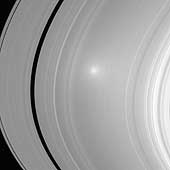|
COMETS EARTH JUPITER KUIPER BELT MARS MERCURY METEORITES NEPTUNE OORT CLOUD PLUTO SATURN SOLAR SYSTEM SPACE SUN URANUS VENUS ORDER PRINTS
PHOTO CATEGORIES SCIENCEVIEWS AMERICAN INDIAN AMPHIBIANS BIRDS BUGS FINE ART FOSSILS THE ISLANDS HISTORICAL PHOTOS MAMMALS OTHER PARKS PLANTS RELIGIOUS REPTILES SCIENCEVIEWS PRINTS
|
Related Document
Download Options
Two images of Saturn's A and B ring showcase the opposition effect, a brightness surge that is visible on Saturn's rings when the Sun is directly behind the spacecraft. This view is of the A ring. See PIA08248 for the view of the B ring. The opposition effect exists because of two contributing factors. One is due to the fact that the shadows of ring particles directly opposite the Sun from Cassini -- the region of opposition -- fall completely behind the particles as seen from the spacecraft. These shadows are thus not visible to the spacecraft: all ring particle surfaces visible to the spacecraft in these two images are in sunlight and therefore bright. Much farther away from the region of opposition, the ring particle shadows become more visible and the scene becomes less bright. The brightness falls off in a circular fashion around the opposition point. The main factor to the opposition surge in this image is an optical phenomenon called "coherent backscatter." Here, the electromagnetic signal from the rays of scattered sunlight making its way back to the spacecraft is enhanced near the region of opposition because, instead of canceling, the electric and magnetic fields comprising the scattered radiation fluctuate in unison. The images were taken in visible light with the Cassini spacecraft wide-angle camera on July 23, 2006 at a distance of approximately 262,000 kilometers (163,000 miles) from Saturn. Image scale in the radial, or outward from Saturn, direction is 13 kilometers (8 miles) per pixel. |
